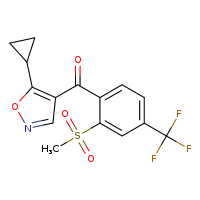Note from Fluoride Action Network
 Structural formula for Isoxaflutole
Structural formula for Isoxaflutole


Warning! According to the harmonised classification and labelling (ATP07) approved by the European Union, this substance is very toxic to aquatic life, is very toxic to aquatic life with long lasting effects and is suspected of damaging the unborn child.
Across the country, many people who’ve never stepped into a soybean or corn field are familiar with pesticides like the cancer-linked glyphosate in Roundup and drift-prone dicamba.
Chances are slim that anyone outside the pesticide and farming industries has heard about isoxaflutole—and that’s exactly how EPA administrator Andrew Wheeler wants it.
But chances are slim that anyone outside the pesticide and farming industries has heard a whisper about isoxaflutole, which earlier this month the Environmental Protection Agency announced it had approved for use on as much as 90 million acres of genetically engineered soybeans in 25 states throughout the Midwest.
And that’s exactly how EPA administrator Andrew Wheeler wants it.
Pronounced EYE-sox-Ah-FLUTE-ole, isoxaflutole is a highly toxic pesticide the EPA has linked to cancer and liver damage. And much like dicamba, it’s well-known for its ability to drift more than a thousand feet from where it’s sprayed, creating potential for broad, unintended damage to nearby crops, backyard gardens and native plants.
The EPA’s announcement that isoxaflutole had been approved for use on millions of acres of genetically engineered soybeans without any prior public notice spotlights how aggressively the Trump EPA under Wheeler’s iron hand has moved to exclude the public and independent scientists from the pesticide approval process.
In making the EPA over in his own secretive, corporate image, the former coal lobbyist has broken with the decades-long practice of providing public notice of comment periods on pending pesticide decisions known to be of broad interest.
Instead, Wheeler orchestrated a covert safety review process that did not provide any public notice that a comment period was open while at the same time actively soliciting comments from pesticide and industrial farming interests.
As a result, the agency received nothing but glowing reviews of its proposed action while the public and leading independent scientists were purposefully excluded from the approval process.
Far from an exception, the behind-closed-doors approach to approving dangerous poisons sprayed on America’s cropland has become business-as-usual under an autocratic Trump EPA.
This same opaque process was used last year when the EPA suddenly re-approved and expanded use of the bee-killing sulfoxaflor, a neonicotinoid insecticide that it approved for use across 200 million acres of cotton, corn, sorghum and citrus crops.
A few years after the EPA’s original approval of the pesticide in 2013, the Ninth Circuit Court of Appeals cancelled the approval of sulfoxaflor after determining the agency based its decision on flawed and limited data.
Thereafter, to achieve its goal of re-approving sulfoxaflor, the Trump EPA made sure no one was able to register their complaints about the disturbingly pro-industry bias of its review by offering no public notice or chance for independent researchers to comment on the re-approval decision.
The same failure to notify the public allowed the EPA to quietly extend so-called “emergency” use of the medically important antibiotic streptomycin on citrus crops in Florida and California this year.
The “emergency” approvals were highly controversial not only because they sidestepped the normal safety reviews but because the World Health Organization has discouraged overuse of streptomycin due to the fact that it is considered “critically” important to treating human diseases, including tuberculosis.
The massive expansion of isoxaflutole use vividly exposes the dirty secret of those who profit off pesticides and genetically engineered seeds: The push to facilitate the use of genetically engineered crops is increasingly accompanied by a dramatic increase in pesticide use.
As a result herbicide use is skyrocketing in the U.S., up 30 percent from 2005 to 2012.
The unavoidable truth is that it’s only a matter of time before plants will develop resistance to isoxaflutole—as they have already done for glyphosate and dicamba.
And that means it’s only a matter of time before those who profit off of pesticide-intensive farming will insist on adding yet another poison to the ever-growing number dumped on hundreds of millions of acres of U.S. cropland.
Nathan Donley, Ph.D. is a former cancer researcher who now works at senior scientist specializing in pesticide policy at the Center for Biological Diversity.
His views do not necessarily represent those of Environmental Health News, The Daily Climate or publisher, Environmental Health Sciences.
*Original article online at https://www.ehn.org/epa-new-pesticide-regulations-2645813787.html
